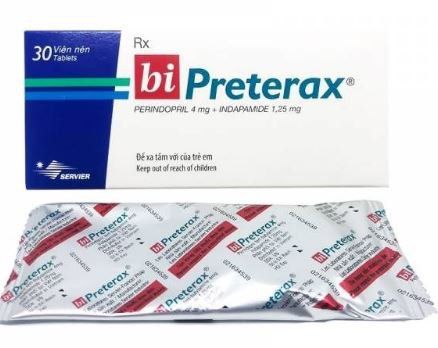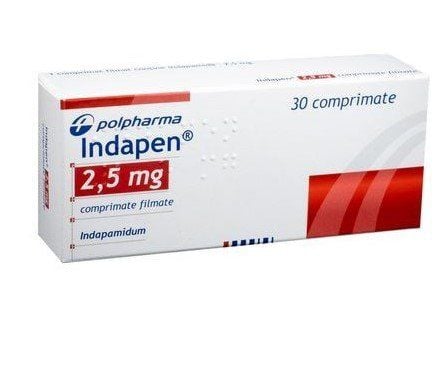This is an automatically translated article.
Prenewel contains the active ingredients Perindopril (an angiotensin-converting enzyme inhibitor) and Indapamide (diuretic). The pharmacological properties of the drug are the combination of pharmacological properties and synergistic effects of the two ingredients in the formulation.1. What is Prenewel?
Prenewel contains the active ingredients Perindopril and Indapamide. Perindopril is an angiotensin-converting enzyme inhibitor, while Indapamide is a diuretic. The pharmacological properties of the drug Prenewel are a combination of the pharmacological properties and synergistic effects of the two active ingredients.
The mechanism of action of 2 active ingredients is as follows:
Perindopril inhibits angiotensin-converting enzyme (ACE) - an enzyme capable of converting angiotensin I to angiotensin II, stimulating the secretion of aldosterone from the adrenal cortex and the breakdown of bradykinin (vasodilator) to form inactive heptapeptides. The result is decreased secretion of aldosterone and water salts, vasodilation, . Indapamide is a sulfonamide derivative that is pharmacologically related to the thiazide diuretic class. Indapamide inhibits sodium reabsorption. The drug also increases the excretion of sodium and chloride in the urine and a part of potassium and magnesium, leading to hypotension. The combination of perindopril and indapamide did not change the pharmacokinetics of either drug compared to when used alone. Prenewel is rapidly absorbed from the gastrointestinal tract, peak plasma concentrations are reached about 1 hour after dosing.
2. Uses of Prenewel
Indicated in patients whose blood pressure is not controlled on perindopril alone.
3. Dosage of Prenewel
Prenewel 4 mg/1.25 mg tablets:
Take one Prenewel 4 mg/1.25 mg tablet daily, preferably in the morning and before meals. Prenewel 4 mg/1.25 mg should be used when blood pressure is not well controlled by Prenewel 2mg/0.625 mg. Prenewel 8 mg/2.5 mg tablets:
The usual dose is one tablet of Prenewel 8 mg/2.5 mg/day, preferably in the morning and before meals. Elderly:
Prenewel therapy for elderly patients should be initiated after considering blood pressure response and renal function. In the elderly, serum creatinine is adjusted with respect to age, weight, and sex. Elderly patients can be treated with Prenewel 8 mg/2.5 mg if renal function is normal. Patients with renal impairment:
Patients with moderate renal impairment (CrCl 30 - 60 ml/min), it is recommended to initiate treatment with an appropriate dose. Note that in patients with severe and moderate renal impairment (CrCl less than 60 ml/min), Prenewel 8 mg/2.5 mg tablets should not be used. For patients with a CrCl of 60 ml/min or more, no dosage adjustment is required. Patients with hepatic impairment:
Prenewel is contraindicated in patients with severe hepatic impairment. No dose adjustment of Prenewel is required for patients with moderate hepatic impairment. Children:
Prenewel should not be used in children and adolescents because efficacy and safety have not been established.
4. Contraindications to Prenewel
Prenewel is contraindicated in the following patients:
Hypersensitivity to the active ingredient or any ingredient in Prenewel. There is a history of angioedema associated with previous use of an ACE inhibitor. Hereditary or idiopathic angioedema. Pregnant women. Breastfeeding women. Combining Prenewel with a product containing aliskiren is contraindicated in patients with diabetes mellitus or renal impairment (GFR < 60 ml/min/1.73 m2). Severe renal failure (CrCl less than 30 ml/min). Hepatic encephalopathy, severe liver failure.
5. Side effects of Prenewel
When using Prenewel, patients may experience some of the following undesirable effects:
Frequency 1 to 10%:
Central nervous system: Headache, dizziness. Endocrine and metabolic: Hypokalemia or hyperkalemia. Gastrointestinal: Nausea and vomiting, dyspepsia. Musculoskeletal: Joint pain. Kidney: Increased blood urea nitrogen. Respiratory: Cough, upper respiratory tract infection, bronchitis. Frequency not determined:
Cardiovascular: Transient ischemic attack. Central nervous system: Loss of consciousness. Kidney: Renal colic. Frequency <1%:
Perioral abscess, abdominal pain, acute renal failure. Acute rhinitis, agranulocytosis. Allergic rhinitis . Changes in salivation, angina, angioedema. Anorexia, anxiety, aplastic anemia. Shoulder periarthritis, asthma, atrial fibrillation, back pain. Benign prostatic hyperplasia, blurred vision. Brachial plexus disease, bradycardia, bronchospasm,...
6. Notes when using Prenewel
Angioedema: At any time during treatment (especially after the first dose) angioedema due to ACE inhibitors can occur. Angioedema may involve the head and neck or the intestines. Early and aggressive management is important when patients have drug-induced angioedema. Cholestatic Jaundice: Rare toxicity associated with ACE inhibitors includes cholestatic jaundice, which can progress to fulminant hepatic necrosis (sometimes fatal). Therefore, the drug should be discontinued if there is a marked increase in liver transaminases or jaundice. Consider discontinuing treatment if symptoms of liver damage (eg, fever, malaise, myalgia, rash) develop during the initial period of treatment. Central nervous system depression: Perindopril may impair physical or mental capabilities. Patients should therefore be warned against performing tasks that require mental alertness (eg, operating machinery or driving a vehicle). Cough: An ACE inhibitor cough is a dry cough and usually occurs during the first few months of treatment, which resolves within 1 to 4 weeks after discontinuation of use. Electrolyte disturbances have been reported at recommended doses. Risks may be dose dependent, so use the lowest possible dose. Electrolyte monitoring should be performed periodically during treatment. Ocular effects: Indapamide may cause a characteristic reaction leading to acute angle-closure glaucoma. Onset of symptoms (eg, decreased vision, eye pain) usually occur within hours to weeks of starting treatment and can lead to permanent vision loss if left untreated. The risk may be increased in patients who are allergic to sulfonamides or penicillins. Sensitive to light. Neutropenia, agranulocytosis, thrombocytopenia, and anemia have been reported in patients receiving ACE inhibitors. Pregnancy: Drugs that act directly on the renin-angiotensin system can cause harm and death to the developing fetus. Therefore, Prenewel should not be used during pregnancy. Patients who are taking the drug should stop immediately when pregnancy is detected. Lactation: The use of Prenewel is contraindicated in lactating women. Above is information about the uses, dosage and notes when using Prenewel medicine. To ensure the safety of your health and maximize the effectiveness of treatment, you need to take the medicine exactly as directed by your doctor.
Please dial HOTLINE for more information or register for an appointment HERE. Download MyVinmec app to make appointments faster and to manage your bookings easily.













